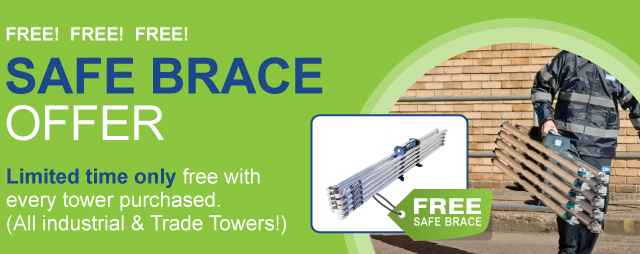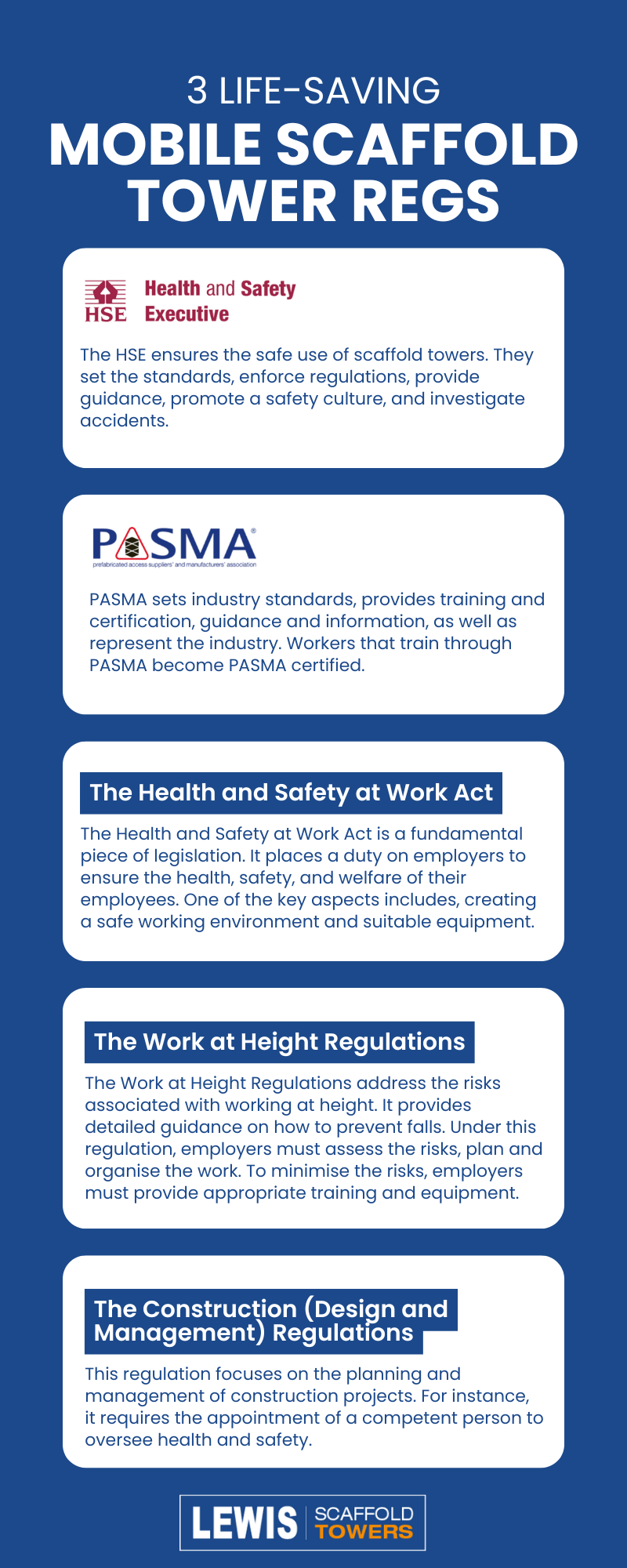Did you know mobile scaffold tower regulations apply to employers, employees and contractors?
This form of access equipment plays a crucial role in the construction industry. It offers a safe and efficient platform for workers to perform tasks at heights.
Having said that, there are strict regulations are to ensure the safety of workers and the public. So, those working with scaffold towers must have an understanding of the regulations.
Scaffold Tower Regulatory Body
Health and Safety Executive (HSE)
The HSE ensures the safe use of scaffold towers. Its primary responsibilities include:
Setting Standards
The HSE sets the legal framework for workplace health and safety. This includes the Work at Height Regulations, which apply to the use of scaffold towers.
Enforcing Regulations
The HSE has the power to inspect workplaces. It also has the power to enforce compliance with health and safety laws. It means they can issue improvement notices and prohibition notices. In cases of serious breaches, the HSE can prosecute offenders.
Providing Guidance
The HSE offers comprehensive guidance on safe scaffold tower use. This includes information on risk assessment, inspection, maintenance, and emergency procedures.
Promoting Safety Culture
The HSE strives to raise awareness of scaffold tower safety. They do this through campaigns, publications, and training initiatives.
Investigating Accidents
The HSE will investigate any scaffold tower-related accident to determine the cause and identify any breaches of safety regulations.
Professional Body
Professional Association for Scaffolding Management and Access (PASMA)
The Professional Association for Scaffolding Management and Access (PASMA) is a professional body. Its role focuses on promoting safety and best practices when it comes to scaffold towers.
Industry Standards
PASMA sets the standards for the safe use and management of mobile access towers. The industry recognises its guidelines and adopts them in practice.
Training and Certification
PASMA provides comprehensive training courses for anyone involved with mobile access towers, including users, supervisors, and managers. Upon completion, attendees receive PASMA certification.
Guidance and Information
PASMA offers a wealth of information and guidance on scaffold tower safety. It includes technical advice, best practices, and safety alerts.
Industry Representation
PASMA represents the interests of the mobile access tower industry. It works with the HSE and other stakeholders to influence legislation and regulations.
Accreditation
PASMA operates a scheme for accrediting training providers. It ensures that training meets the highest standards.
Mobile Scaffold Tower Regulations Breakdown
There are several mobile scaffold tower regulations:
- Health and Safety at Work Act
- Work at Height Regulations
- Construction (Design and Management) Regulations
These regulations outline the responsibilities of employers, contractors, and employees.
The Health and Safety at Work Act
The Health and Safety at Work Act is a fundamental piece of legislation. It places a duty on employers to ensure the health, safety, and welfare of their employees. One of the key aspects includes, creating a safe working environment and suitable equipment.
The Work at Height Regulations
The Work at Height Regulations address the risks associated with working at height. It provides detailed guidance on how to prevent falls. Under this regulation, employers must assess the risks, plan and organise the work. To minimise the risks, employers must provide appropriate training and equipment.
The Construction (Design and Management) Regulations
This regulation focuses on the planning and management of construction projects. For instance, it requires the appointment of a competent person to oversee health and safety.
Roles and Responsibilities under the Law
I wrote a comprehensive blog that shares 16 scaffold tower safety tips. I’ve summarised the main roles and responsibilities stipulated by the mobile scaffold tower regulations below.
Employers
Employers are responsible for providing appropriate equipment that is safe to use. In addition, they must provide appropriate training. This is to ensure that workers are competent to use it. As mentioned, you can access this training through PASMA or its approved providers.
Employees and Contractors
Employees and contractors have a duty to follow the established guidelines and procedures. This includes using the mobile scaffold tower as per guidelines and procedures. They must wear appropriate personal protective equipment such as non-slip shoes. And, report any defects or hazards with regard to the access equipment.
Inspections
In a construction setting, employers must inspect mobile scaffold towers every seven days. Inspections are due following significant changes or incidents too. Any defects or damage should be repaired or replaced to prevent accidents before its used again.
Training
Employers must provide adequate training to workers. It must cover topics such as assembly, dismantling, and safe use of the scaffold towers. Competent individuals can provide such training.
Communication
Communication of responsibilities must be clear and evident. Sharing of information on potential hazards should be noted and dealt with. Regular consultation to address any concerns or suggestions for improvement.
Conclusion
In conclusion, mobile scaffold towers are indispensable tools in the construction industry. Having said that, their use necessitates strict adherence to regulations. Employers, employees, and contractors all share responsibility for ensuring scaffold tower safety. The HSE sets safety standards, enforces regulations, and promotes a safe work culture. While, PASMA offers vital industry guidance, training, and certification. By complying with these mobile scaffold tower regulations, together we can create an even safer construction industry.



